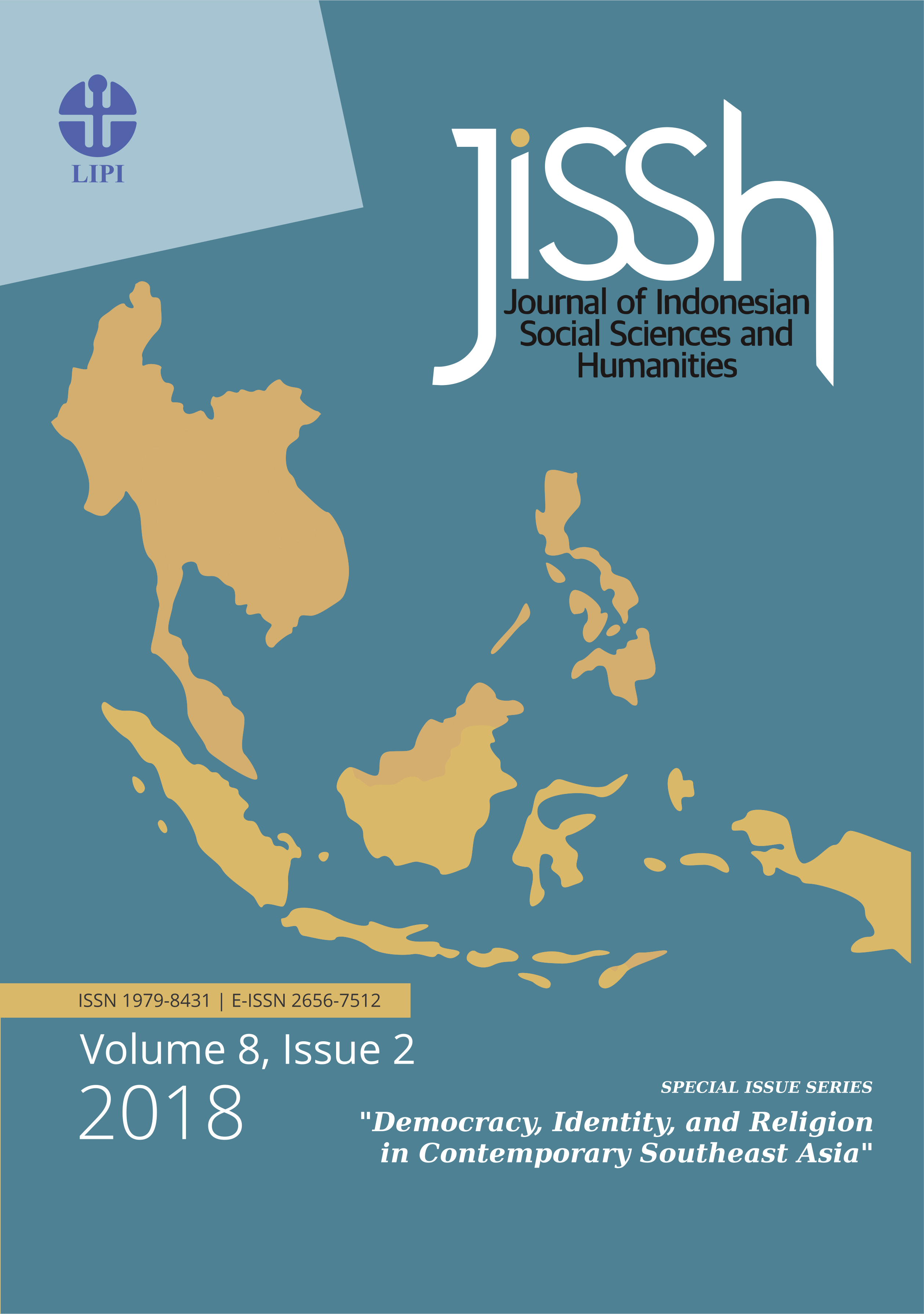Negotiating the Space for Peace: Interreligious Tolerance and Harmony in Practice
Keywords:
negotiation, space, Inter-religious Tolerance, House of Worship, narration, peace and harmonyAbstract
Nowadays, Indonesia well known as tolerance country has been facing a severe problem with the practice of intolerance act and radicalism. Recently, we were shocked by some news about a young man attacking St. Lidwina Bedog church, Yogyakarta, and the suicide bombing at three churches in Surabaya. Several innocent civilians became the victim from these actions. Besides, we can note that there was another intolerant act regarding the building of a house of worship and conflict among religious believers in some district in Indonesia. These situations indicated that actors who attempted to destroy Indonesia’s unity through harmful narratives of Indonesian diversity and threaten Indonesian tolerance are ranging from ethnicity, language, to religion. This article proposes a counter-narrative for Indonesian harmony by identifying the places of house of worship and spaces of religious tolerance activities. Since the establishments of the house of worship in several places have led to a disharmony and intolerance act, this article found another story of tolerance based on a house of worship location and space of tolerance activity. Field research was conducted in Balun Village, Lamongan, where three houses of worship built neighboring in the village. These neighboring houses of worship and religious activities around support the idea called “negotiating the space of peace.” The data collection methods included participant observation and interview. The findings show that religious diversity of Indonesian citizens is based on unity and peace. The neighboring houses of worships (Mosque, Church, Pura/ Hinduism temple, etc.) in Lamongan, show that the tolerance among different religious believers has been there as long as Indonesian history. It is not only the negotiation in terms of physical space where the house of worship built but also non-physical space among religions and their believers, which build and strengthen the peace among them. Therefore, the peace situation and condition become the central point regardless of their background (ethnicity, religions, and language).
References
Abbas, M. R. (2016). Peace in the Midst of Violence: Analyzing the Role of Elites in Preserving Peace and Harmony in Manado. Indonesian Journal of Islamic Literature and Muslim Society, 1(1), 1-28. http://dx.doi.org/10.22515/islimus.v1i1.214
An-Naim, A. A. (2008). Islam and the Secular State: Negotiating the Future of Shari’a. England: Harvard University Press. Belajar pluralisme dari Balun. (2017, Juni 3). https://beritagar.id/. Retrieved from https:// beritagar.id/artikel/laporan-khas/belajar- pluralisme-dari-balun. Accessed on 9 April 2018.
Benhabib, S. (1992). Models of Public Space: Hannah Arendt, the Liberal Tradition, and Jurgen Habermas. In Situating the Self: Gender, Community, and Postmodernism in Contemporary Ethics. Cambridge: Polity Press. pp. 89-120.
BPS Lamongan. (2018). Kecamatan Turi dalam Angka 2018. Lamongan: Badan Pusat Statistik Kabupaten Lamongan.
Brodin, L. J. (2004). Illusion of Freedom. Dissertation submitted to the Faculty of the Graduate School of the University of Maryland.
Creswell, J. W. (2016). Educational Research: Planning, Conducting, and Evaluating Quantitative and Qualitative Research. 4th Edition. Boston: Pearson.
Dhofier, Z. (2011). Tradisi Pesantren: Studi Pandangan Hidup Kyai dan Visinya Mengenai Masa Depan Indonesia. Jakarta: LP3ES.
Febbinawati, F. (2015). Potensi Konflik Antara Penganut Agama Islam dan Kristen: Studi Kasus Pendirian Rumah Ibadah di Desa Sungai Sirih, Kecamatan Singingi, Kabupatan Kuantan Singingi. Skripsi S1 Jurusan Perbandingan Agama. Riau: Fakultas Ushuluddin, UIN Sultan Syarif Kasim Riau.
GKJW. (n.d.). Tentang GKJW. Retrieved from: https:// gkjw.or.id/tentang-gkjw/sejarah/. Accessed on 24/06/2019.
Ini Kronologi Kasus Penistaan Agama Meiliana di Tanjung Balai. (2018, Agustus 23). Tempo. Retrieved from https://nasional.tempo.co/ read/1119663/ini-kronologi-kasus-penistaanagama-meiliana-di-tanjung-balai. Accessed on 24 August 2018.
Kemdikbud (n.d). KBBI Daring. Retrieved from https://kbbi.kemdikbud.go.id/entri/kerja%20 bakti. Accessed on 24/06/2019.
Latif, Y. (2011). Negara Paripurna: Historisitas, Rasionalitas, dan Aktualitas Pancasila. Jakarta: PT. Gramedia Pustaka Utama.
Lufaefi, L. (2017). Rekonstruksi Jargon Formalisasi Syariat: Upaya Menjaga Persatuan dalam Bingkai Keberagaman. Al-A’raf : Jurnal Pemikiran Islam dan Filsafat, 14(1), 73-90. DOI: 10.22515/ ajpif.v14i1.805
Prabowo, M. N. (2016). Kerukunan Umat Beragama Sebagai Cita-Cita Etis (Sebuah Tinjauan Etika). Sosiologi Agama; Jurnal Ilmiah Sosiologi Agama dan Perubahan Sosial, 10(1), 21-42. https://doi. org/10.14421/jsa.2016.101-02
Qurtuby, S. A. (2012). Reconciliation from Below: Indonesia’s Religious Conflict and Grassroots Agency for Peace. Peace Research, 44/45(2/1), 135–162.
Robbinson, E. (2008). Rethinking Public Space: a New Lexicon for Design. Urbani izziv, vol.19, No.2, 2008.
Sutikno. (2016). Satu Dusun Tiga Agama: Konstruksi Toleransi Keagamaan di Dusun BalunLamongan. Lamongan: Pustaka Ilalang in cooperation with Badan Perpustakaan dan Arsip Daerah, Pemkab Lamongan.
Taufiqurrahim. (2017). An Ecological View of the Religion and Noise Pollution: Does it Make Sense? In proceeding IGSSCI 9th 9-10 August 2010, with theme “Sustaining The Planet: Call for Interdisciplinary Approach and Engagement. Yogyakarta: The Graduate School of Universitas Gadjah Mada
Downloads
Published
Issue
Section
License

This work is licensed under a Creative Commons Attribution-ShareAlike 4.0 International License.
Authors who publish with this journal agree to the following terms:
1. Authors retain copyright and grant the journal right of first publication with the work simultaneously licensed under an Attribution-ShareAlike 4.0 International (CC BY-SA 4.0) license. This license allows others to remix, adapt, and build upon the work, as long as they credit the author and license their new creations under the same terms.
2. Authors may enter into separate, additional contractual arrangements for the non-exclusive distribution of the journal’s published version of the work (e.g., posting it to an institutional repository or including it in a book), provided there is an acknowledgment of its initial publication in this journal.
3. Authors are permitted and encouraged to post their work online (e.g., in institutional repositories or on their personal website) prior to and during the submission process, as this can lead to productive exchanges and increase citations of the published work (See The Effect of Open Access ).


















